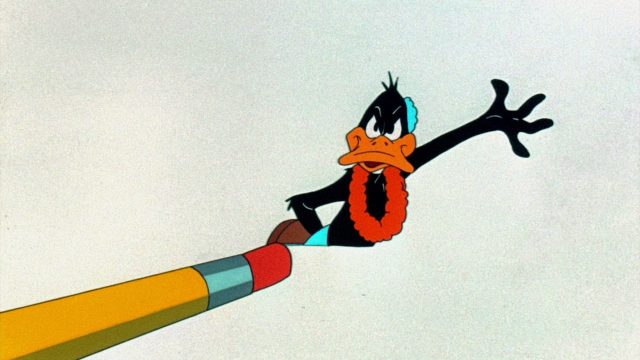Daffy Duck is one of the looniest of all the Looney Tunes. During the Golden Age of Warner Bros. cartoons, Daffy appeared in 130 of the Looney Tunes/Merrie Melodies animated shorts. Whether as a foil for Bugs Bunny or Elmer Fudd, starring with his friend/sidekick Porky Pig, or heading his own ego-tastic misadventures, Daffy’s particular charms have kept children and adults entertained for 86 years and counting.
Animation master Tex Avery created Daffy in 1937 for Porky’s Duck Hunt directed by Avery and animated by another master, Bob Clampett. Avery’s version of Daffy acted as a chaotic force prone to bouncing off the walls and ceiling. In Porky’s Duck Hunt, Daffy even bounces off the words in the end title card. Back then, he looked more like a duck, a little softer and rounder, with a smaller bill and head. Daffy underwent several redesigns in the ensuing years, but it wasn’t until he was overshadowed by a wascally wabbit named Bugs Bunny that master director/animator, Chuck Jones, redesigned him to be less force-of-nature and more greedy and craven. His bill is more pronounced (the better to wrap around his head whenever Elmer shoots him), his patter wittier, and his overall demeanor a lot less wacky.
Duck Amuck, a Merrie Melodies short directed by Jones (credited as “Charles M. Jones”), is nearly seven minutes of inspired insanity, all of it at Daffy’s expense. The plot sees him struggling to get a grip on the cartoon he’s appearing in, as its ever-changing landscape and constant wardrobe shifts drive him cuckoo. Is he a pilot? A sailor? A singing cowboy? A mutant flower-faced quadruped? Poor Daffy doesn’t know as an unseen artist keeps erasing and redrawing the cartoon around him while Daffy tries gamely to get into character.
The cartoon starts with Daffy playing a musketeers until the background goes completely white. Daffy breaks the fourth wall, asking the unseen animator to give him some scenery and is gifted a farm tableau, which doesn’t fit with his musketeer outfit. Soon, he’s changing costumes over and over as his reality keeps being redrawn.
It’s not just the backgrounds, either, as the unseen foe messes with the sound effects. The surreal situation has Daffy first trying to work with what’s drawn for him — he’s an actor, after all, and he must rise to the occasion. But by the end of the picture, he’s reduced to yelling at whoever is animating this mess. And who is his tormentor? None other than his greatest foe: Bugs. “Ain’t I a stinker?” Bugs giggles after he closes a literal door on the hapless duck.
The same scenario would be repeated in 1955’s Rabbit Rampage, which sees Bugs himself at the mercy of an unseen animator bent on tormenting him. It’s no surprise the animator turns out to be the oft-beleaguered target of Bugs’ own shenanigans, Elmer Fudd.
In 2007, the popular cartoon became a video game titled Looney Tunes: Duck Amuck. Duck Amuck is also one of the three Chuck Jones cartoons preserved in the National Film Registry.
Above all, Duck Amuck is a gleeful, surreal excursion through the animation process, compressed into one cartoon and starring one poor tortured soul named Daffy. It’s a timeless classic and one of my favorite cartoons ever, one my friends and I still quote to this day.

